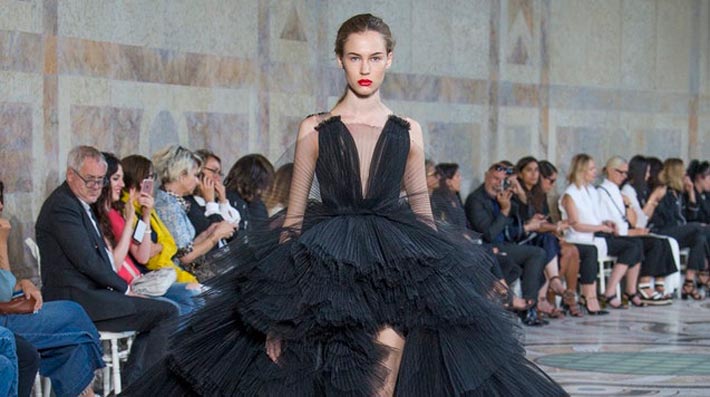Last week, Artémis, the mega holding company of the Pinault family, announced that it has acquired a minority stake in Giambattista Valli. But why didn’t Kering just make the investment itself?

PARIS, France — As Giambattista Valli took his finale walk to rapturous applause at his Paris couture show on Monday, he stopped and bowed to none other than François Pinault, who sat front row. In response, Pinault stood and embraced the designer. The display of familiarity between the two men follows news last week that Artémis, the holding company of the Pinault family, had acquired a minority stake in Maison Valli for an undisclosed sum.
While the investment is notable — not least because Valli has, until now, never taken investment — the fact that the stake was acquired by Artémis, and not Kering, which is helmed by Mr Pinault’s son François-Henri Pinault, raised some eyebrows.
Previously, the Pinault family has made several high-profile investments in smaller fashion businesses through Kering, including Alexander McQueen (in 2001), Stella McCartney (in 2001) and Christopher Kane (2016). So, what is the mysterious Artémis Group and what difference does it make to Giambattista Valli that Artémis, and not Kering, made the investment in his brand?
The investment arm of the Pinault family, Artémis was founded in 1992 by François Pinault, and holds the family’s majority stake in Kering. Artémis also controls the Château Latour vineyards, auction house Christie’s, publication Le Point and the Stade Rennais Football Club, with total assets exceeding $34 billion.
The reason Artémis ultimately invested in Maison Valli, and not Kering, is likely because the latter has a tendency to prefer majority stake investments, says Mario Ortelli, senior research analyst for luxury goods at Sanford C. Bernstein. “The advantage for Kering is in bringing its own manager equities and its synergies in distribution and production,” says Ortelli, referring to the other acquisitions as examples.
In a deal with Giambattista Valli — a staunchly independent designer who has maintained full control of his brand since its launch in 2004 — Kering would be unable to impose its management strategies without a majority share. “Valli probably wanted to have control of the management of the company and was just looking for a financial partner,” says Ortelli. “That’s why I don’t think that this was a transaction that would be interesting to the Kering group.”
If Ortelli’s assessment is correct, the Maison Valli investment would not be unlike Artémis’ rumoured 2015 acquisition of a 30 percent stake in Courrèges. But it was Kering, not Artémis, that made a minority investment in Altuzarra in 2013, indicating that the luxury conglomerate is not entirely averse to minority investments.
Valli himself has stated a previous preference for independence. “Being independent gives me the chance to write my own story the way I want to write it, and that's priceless," Valli told BoF in 2015. Thus far, Valli has self-financed his namesake line, in part by consulting for Max Mara Atelier and directing Moncler Gamme Rouge.
One other theory is that the business needed a financial boost. Valli’s diffusion line, Giamba, no longer shows in Milan, and has been blighted by talk of closure, though a representative for the designer insisted that such rumours are unfounded. The new financial injection from Artémis undoubtedly takes pressure off Valli, but it also means he will have to share in at least some decision-making with his new investors.
A spokesperson for Artémis was not available for comment at the time of publication, but if Pinault’s front-row support on Monday is anything to go by, he has a personal interest in Valli’s capacity for growth. “Maybe the Pinault family was interested in this brand’s potential and I think that Artémis is a private vehicle for this,” says Ortelli.
Source: businessoffashion.com
